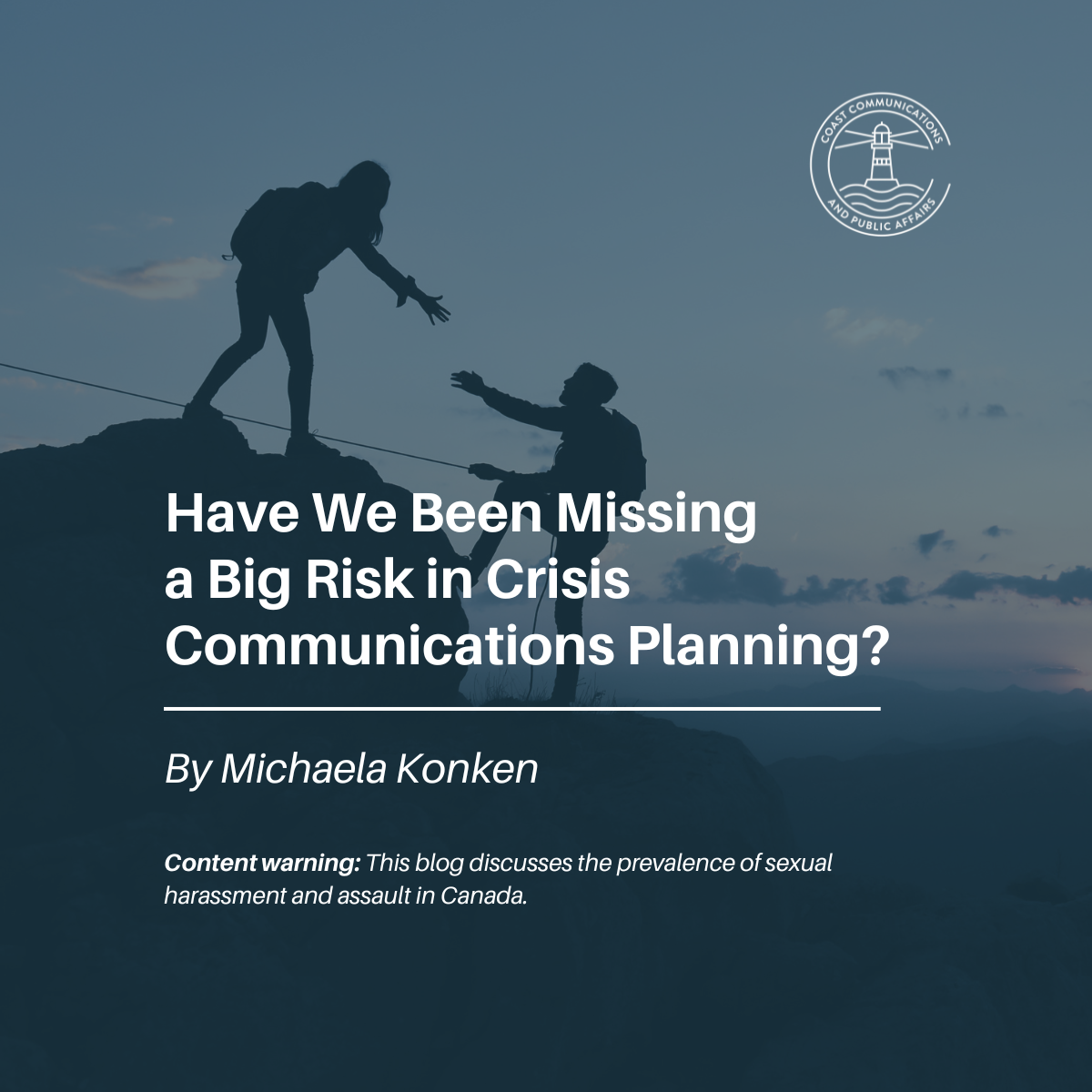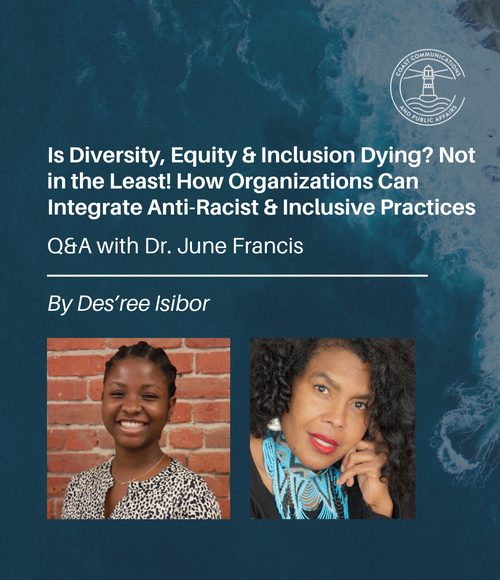Content warning: This blog discusses the prevalence of sexual harassment and assault in Canada, primarily in workplaces.
Disclaimer: Michaela Konken is currently serving on the board of directors of Salal Sexual Violence Support Centre.
Do we need to incorporate sexual harassment, misconduct and violence into crisis comms plans and risk assessments?
When we’re preparing crisis communications plans for organizations, we often include ‘embezzlement, financial mismanagement or other major wrongdoing by senior staff’ in the issues matrix. But we don’t specifically include any mention of sexual misconduct, either in the plan or when discussing issues and risks with the client. Are we ignoring a big problem?
Since the #MeToo movement started in 2017, there have been a lot of high-profile cases involving celebrities and public figures, often ruining the reputations of those accused. For cases close to home in Canada, the Hockey Canada and Canadian Armed Forces scandals immediately come to mind.
While some think the #MeToo era is over, recent studies and reports show that incidents of sexual harassment and assault are still alive and well — 30 per cent of all women aged 15+ report experiencing sexual assault at least once, according to the Canadian Women’s Foundation. If you’re about to make the argument that it’s just some bad eggs, read on.
How Common are Sexual Harassment and Violence in Canadian Workplaces?
Sexual harassment in the workplace is actually extremely common. In 2021, the Government of Canada released an article referencing data from the 2020 Survey on Sexual Misconduct at Work, which found that:
- 25% of women and 17% of men experienced sexual misconduct in their workplace
- 47% of workers either witnessed or experienced some sort of inappropriate sexualized or discriminatory behaviour in a work-related setting
- 22% -28% of women and 21%-30% of men experienced inappropriate sexualized behaviours perpetrated by a person in authority, such as a supervisor or boss (depending on the type of behaviour experienced)
- 32% of women and 26% of men said that their employer had not provided them with information on how to report sexual harassment and sexual assault
A study in April 2022 that surveyed almost 5,000 Canadian workers found that, in the two years prior to taking the survey, 43.9% of surveyed workers “experienced at least one behaviour or practice of sexual harassment and violence” while at work. Of those who experienced sexual harassment and violence, most were “very dissatisfied” (average of 50.5%) with the actions and “response they received from those responsible for workplace health and safety in their workplace.”
Statistics Canada released new data in February 2024, which includes some eye-opening numbers. 47% of women and 31% of men in Canada “reported ever experiencing some form of harassment or sexual assault in the workplace.”
Let those numbers sink in.
This is not just a few ‘bad eggs.’ It is a systemic issue. It means that many of our workplaces are not safe. And they are even less safe for people from underrepresented backgrounds — women of colour, Indigenous people, LGBTQ2A+ people and people with disabilities experience harassment at a higher rate than able-bodied, cisgendered, heterosexual white people, as identified by the Canadian Women’s Foundation and the 2020 Survey on Sexual Misconduct at Work study.
For the full details on these facts and figures, as well as more information and resources, scroll to the bottom of this blog post.
Why is Sexual Harassment Absent from Crisis Communications Plans?
So, if sexual harassment and violence are so prevalent in our workplaces, why are public relations professionals not addressing this in crisis communications plans? We don’t usually shy away from identifying potential troubling risks, so why is this one different?
Despite continuing to be prevalent throughout our society — and workplaces — people are very uncomfortable talking about any form of sexual violence. Sexual harassment is a taboo topic that people avoid and this is part of the problem. Looking at the statistics, sexual violence isn’t going away any time soon, so it’s time our society — and our places of employment — learn how to appropriately deal with it.
Clients request crisis communications plans because they want to be proactive and avoid having a reputational crises down the road. Our industry is in a unique position to not only point out the likelihood of an organization facing accusations of not appropriately dealing with sexual harassment, but to also advise clients to make sure they have the proper policies and procedures in place to make their workplaces safer for everyone.
What Can We Do About Sexual Harassment in the Workplace?
First off, we have to acknowledge the problem. Then we take action. What can organizations and companies do to prevent workplace sexual harassment (and subsequently create a safer work environment and decrease the chance of needing crisis comms support for a sexual harassment incident in the future)? I turned to an expert: Dalya Israel, Executive Director at Salal Sexual Violence Support Centre.
- What are the key factors that contribute to creating a workplace culture that either fosters or prevents sexual harassment?
This is a great question and doesn’t have the most straightforward answer! From Salal’s perspective, we have to, first and foremost, acknowledge that we are living in rape culture. While we should all be working to create safer workplaces and community spaces, we have to understand and be honest about the reality that many folks will bring the influence and impact of our privileges and identities into our workplaces.
Once we have acknowledged this truth, we can work from there to set standards (policies, frameworks, codes of conduct, etc.) and very importantly build a culture that is rooted in consent, questioning power and resisting power over mutuality, collaboration, compassion and accountability to one another. These values can then support people inside of organizations to use the standards that are created; we know that culture will eclipse any written policies, laws, frameworks or practices.
We must remember that sexual violence, anywhere on the continuum, is about power, not sex or sexuality. So, one of the ways in which we can reduce harm and change the conditions that allow harm to happen is by attending to power and the ways it plays out in society and in turn in the workplace.
- What steps can companies take to create safe reporting mechanisms for employees who experience or witness sexual harassment?
Another great question. My answer will be a bit more straightforward for this one! We know that it’s vital for folks who are coming forward to have their autonomy recognized. One of the ways we can be “Trauma Informed” with reporting and accountability options is by really being cognizant of how the reporting process alone provides survivors of sexual harm with an opportunity to regain some control over their experience. This means if you are someone responsible for taking a disclosure, ensure that you are not running away with a process; instead listen to the person who is disclosing harm and know that they are the expert of their own reality and are asking for collaboration and support, not to be rescued.
Honouring that survivors should be able to choose their own path to healing and justice is a key value at Salal and we deeply believe that as a society we should all be aligning our responses to sexual harm in this way.
We can also do more than simply believe survivors, we also need to believe that holding folks accountable that cause harm is also necessary and vital for a safe and healthy workplace and culture. Accountability does not always look the same. First, we need to listen to survivors and, as employers, we need to be building a multitude of different ways of attending to harms with the goal of decreasing future harm. We should also be considering the support and healing for those who have been harmed, skilling people up to intervene, having restorative approaches when appropriate, and mechanisms in place when the organizational culture is no longer aligned with values that will support a right relationship with power.
Most importantly, we must recognize that part of the reality of rape culture is that survivors are often blamed for the sexual harm they have experienced, so first and foremost we must wrestle with this reality; disclosing sexual harm takes courage and energy. We must remember that not only are we asking survivors to come forward and tell us what happened to them in possibly the worst time of their life, we are also asking them to trust that we have done our own work to unravel ourselves form rape culture enough to respond with compassion and care and take the necessary steps to offer support and accountability.
- Could you share any success stories or best practices for dealing with sexual harassment in the workplace?
I think first and foremost when we’re thinking about “success” we need to measure it through the journey of the survivors we hope to support. At Salal we often start by initially asking what survivors are hoping for when it comes to accountability or justice. Oftentimes those are the conversations that will truly illuminate what a survivor knows they need, and want, then the task becomes finding a path forward. A path forward may look like providing information, building important bridges to other resources, setting them up to be supported while navigating systems and really focusing on ensuring that the process employs autonomy-based practice; namely keeping the survivor informed about decisions and options being explored.
Resisting a cookie cutter approach and meeting survivors where they are at will be a hallmark of success. The other part of success will rely on staff members who are responding to the disclosures. Investing in skilling staff members up to respond from a non-judgemental, anti-oppressive, trauma informed approach will go a long way creating a successful outcome for survivors.
Part of Crisis Comms Planning is Mitigation
One of the key benefits of doing crisis communications planning is that it allows you to identify risks and move towards mitigation. By talking about sexual harassment, it can actually make workplaces safer because it forces uncomfortable conversations to happen and encourages more training and policies be put in place to make workplaces safer.
As our society evolves, so does our discipline of communications. As public relations professionals, we need to ensure our recommendations and best practices accurately reflect what’s taking place outside of the Word document.
For companies and organizations, take a look at your current procedures and policies. Is workplace sexual harassment and misconduct appropriately reflected? Do you need to make any additions or updates? Check out the Sexual Harassment Advice, Response, and Prevention for Workplaces project for free information resources (like a policy and procedures template!).
For PR and comms professionals, look at your existing templates for crisis communications plans to see if you can include sexual harassment in your risk matrix. And keep sexual harassment in mind the next time you’re discussing crisis comms with a client.
Information and References
About Dalya Israel
Dalya has been with Salal (formerly WAVAW Rape Crisis Centre) for 19 years. She is passionate about and committed to creating a better world for survivors of sexualized violence.
About Salal Sexual Violence Support Centre
Formerly WAVAW Rape Crisis Centre, Salal is a feminist, anti-oppressive, decolonizing sexual violence support centre operating on unceded Coast Salish Territories. They provide support services to survivors of sexualized violence who have shared experiences of gender marginalization: cis and trans women, Two-Spirit, trans and/or non-binary people. They advocate for social and systemic change through education, outreach and activism.
Immediate emotional support is available on Salal’s national toll-free 24-Hour Crisis & Information Line at 1-877-392-7583 and via Salal Connect text at (604)-245-2425.
SHARP Workplaces
The Sexual Harassment Advice, Response, and Prevention for Workplaces project provides free information resources to help employers and workers learn about how to prevent and respond to workplace sexual harassment. The five-year project was developed by the Ending Violence Association of BC and Community Legal Assistance Society, with financial support from the Department of Justice Canada.
It's Not Part of the Job
Comprised of experts and researchers afrom Western University's Centre for Research & Education on Violence Against Women & Children, It's Not Part of the Job provides educational resources focused on preventing and addressing harassment and violence at work.
Facts and Figures
In August 2021, the Government of Canada released an article on the “prevalence, characteristics and impacts of inappropriate sexualized behaviours, discrimination and sexual assault in Canadian workplaces,” which references data from the 2020 Survey on Sexual Misconduct at Work. The infographic from this study can be found here.
The survey found that in the previous year before the study:
- 25% of women and 17% of men experienced sexual misconduct in their workplace
- 47% of workers either witnessed or experienced some sort of inappropriate sexualized or discriminatory behaviour in a work-related setting
- 22% -28% of women and 21%-30% of men experienced inappropriate sexualized behaviours perpetrated by a person in authority, such as a supervisor or boss
- 32% of women and 26% of men said that their employer had not provided them with information on how to report sexual harassment and sexual assault
- inappropriate sexualized behaviours and gender-based discrimination at work were more common among young people, people with disabilities, and LGBTQ2 people
- The study found that, in the two years prior to taking the survey, 9% of surveyed workers “experienced at least one behaviour or practice of sexual harassment and violence” while at work.
- Of the survey respondents who experienced sexual harassment and violence, most were “very dissatisfied” (average of 50.5%) or “somewhat dissatisfied” (average of 10%) with the actions and “response they received from those responsible for workplace health and safety in their workplace.”
- 47% of women and 31% of men in Canada “reported ever experiencing some form of harassment or sexual assault in the workplace.”
According to the Canadian Women’s Foundation:
- Anyone can experience sexual violence, but women, girls and gender-diverse people are at higher risk.
- Women with disabilities are two times more likely than women with no disability
- Indigenous women are three times more likely than non-Indigenous women



